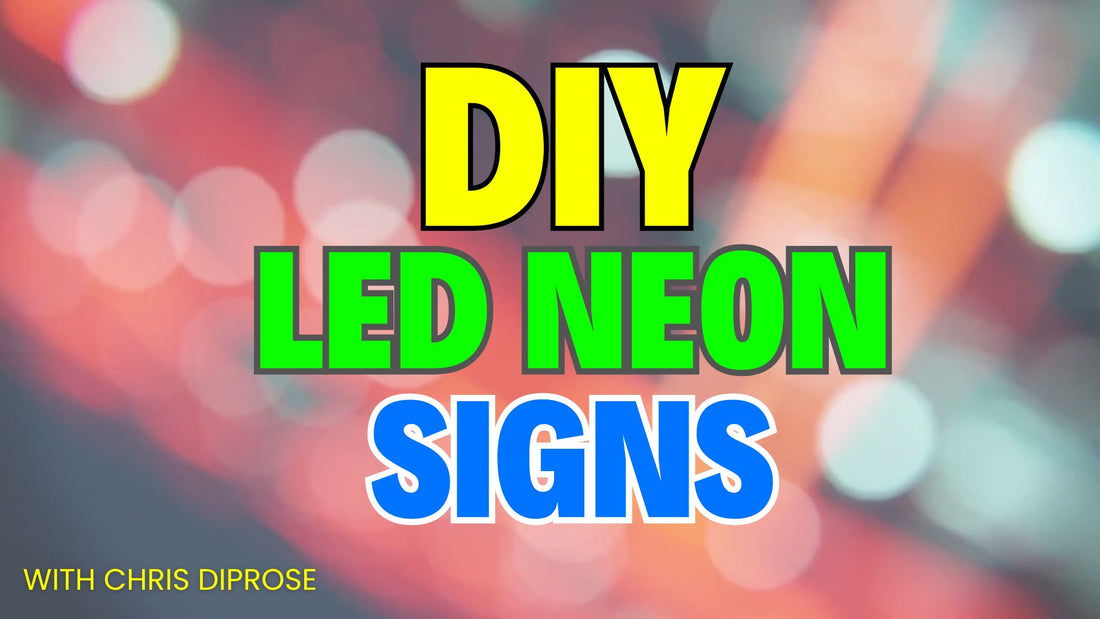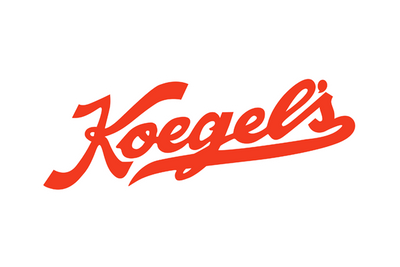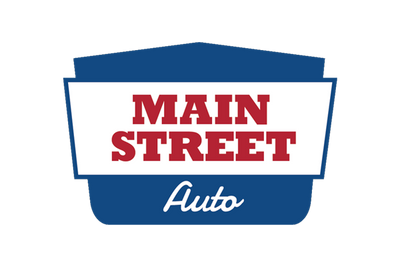
DIY LED Neon Sign - Step-By-Step Guide
Chris DiproseShare
Do you want to create a DIY LED neon sign?
Follow the instructions below to make your own LED neon sign. I have also created a video with detailed instructions outlining the steps involved.
- Creating DIY LED neon signs is possible.
- I have provided detailed instructions on making a DIY LED neon sign.
- LED neon signs are durable, safe for indoor use, and energy efficient.
Let's dive in.
What You Need to Craft an LED Neon Sign
In order to craft a DIY LED neon sign, you will need a few components. Below is a list of all the necessary components. I have also provided a link to an example on Amazon and a link to the full list at the bottom.
- LED neon flex in the desired colors - like this roll of LED neon flex.
- Transparent acrylic sheet at your desired size - like this acrylic sheet.
- Scoring knife - like this scoring knife.
- Superglue - example super glue.
- 12-volt wire - like this wire.
- 120-volt to 12-volt step-down power adapter/transformer and plug - like this transformer.
- Non-slip pad (optional) - like this grip pad.
- Soldering iron and solder - like this soldering iron.
- Scissors or a knife - like this knife.
- Pliers - like these pliers.
- Power drill - an option.
- Stand-offs, screws, hanging wire, or chains - like these stand-offs.
- Remote control with controller (optional)
Here is an Amazon list of all the products I recommend. You may well have several of these items already, but if you don't and if you want to make your own neon sign, then the entire list would likely cost around $350 to buy.

I anticipate that most people have a power drill, a knife, pliers, and a non-slip pad or soft surface to work on - these will reduce the cost quite a bit. However, a DIY LED neon sign isn't as cheap as you might think.
Complications in Design & Manufacture
Shaping & Molding: LED neon flex is a physical medium - it is a strip of LED lights, and therefore, it has limitations on how it can be molded, shaped, and manipulated. LED neon flex requires 2 to 3 inches of width to perform a 180-degree U-bend - this is called the bending radius.
Power: Fortunately, LED neon signs only need 12-volt or 24-volt power and, therefore, are at low risk of electric shock. However, you do need to take care when first plugging the neon sign into the wall and ensuring that you can safely switch the sign off at the wall if necessary.
Creating the LED Neon Sign
There is no hiding from this; creating an LED neon sign is a learned skill that requires someone with experience. Everyone needs to start somewhere, and it doesn't need a lot of experience to get the hang of it.
My initial advice, if you are going to create the neon sign yourself, is to have contingency LED neon flex, backing material, and other components so that you can remake it if you make a mistake.
Here is the process that I recommend people follow to create a DIY LED neon sign:
-
Design: Design the neon sign using CorelDraw, Adobe Illustrator, or PhotoShop. This is called a concept drawing and should be designed to the desired size at a 1:1 ratio. For a 30-inch sign, it would be a 30-inch design.

-
The Trace Design: Edit the design by tracing the lettering or design with a 1/4-inch-wide line. This will be printed and used as a tracing line for the LED neon flex.

- Print the Trace Design: Print the trace design in a 1:1 print. This will be used to trace onto the sign, so make sure it is 1:1 on the printer. In the above example, you will have a 30-inch print.
- Backboard Face Down: Position the backboard on the non-slip pad, and choose the front side of the acrylic backboard. Now, position the front facing down.
- Tape the Design to the Back: Stick the print of the design from step 2 to the back of the backboard (which should be facing up) - ensure it is correctly aligned with the backboard. Stick all edges of the design so it doesn't slip or move. I recommend using masking tape or painter's tape, as it leaves no marks and is easy to source.
-
Backboard Face Up: Flip the backboard over and check that you can see the design and that it is correctly positioned on the sign. Adjust as necessary.

- Backboard Cut: Cut the acrylic backboard to the desired shape—or leave it as is. Note: We use a laser cutter, but for DIY, you can use a scoring knife designed for acrylic.
-
Trace: The goal of this step is to look at the design through the backboard and then trace the design and letters using the LED neon flex.

-
Cut the LED neon flex: Unspool part of the LED neon flex and cut to the desired length to suit and match the letters and design. Mold and shape the LED neon flex.

-
Wire the LED neon flex: The LED neon flex needs to be connected, and wires need to be attached, so use a soldering iron to connect the wire from one letter to the next at the shortest point.

-
Glue the LED neon flex: Attach the LED neon flex piece to the backboard using super glue.

- Cut+Wire+Glue: Repeat steps 9, 10, and 11 until all design sections have been traced with LED neon flex.
-
Last Wire: A wire will need to come off the sign to power the entire sign. Try to position this wire on the LED neon strip closest to the power source.

-
Test: The wires must now be connected to the power transformer. Once you have followed the instructions on the power transformer, you can connect it to the power outlet and test it.

- Drill Holes for Mounting: Now you can drill holes on the sign you want - ensure to drill the holes wider than the wire or screw but smaller than the width of the screw head.
Now that you have completed the neon sign, you can move it to the location where you want it mounted. Here are some detailed instructions on how to hang a neon sign.
You might make some mistakes, so don't be scared to go back and redo certain parts of the sign, or restart entirely if you made some big mistakes.
This multi-step process can take around two or three hours to complete a moderate-sized LED neon sign.
Why Choose an LED Neon Sign instead of a Traditional Neon Sign?
I wrote a full comparison piece on this already - view the full piece - Glass neon vs. LED neon signs.
In summary, traditional neon signs are made with glass tubes filled with inert gases, such as argon, Co2, mercury, or neon. The gas reacts with an electrical current and produces light.
LED neon signs are made with flexible LED neon tubes, most often called LED neon flex. LED neon flex is made of LED strips with chips, which when connected to a power source produce light.
LED lights are safer, stronger, more durable, easier to create, energy-efficient, and brighter - there are literally no tangible advantages that traditional neon signs have over LED neon signs. LED neon signs can be shaped into intricate patterns, and designs, and obviously aren't fragile like the glass tubes used on traditional neon signs. They also don't have hazardous gases inside.
If you want to learn how traditional neon signs are made - view the blog post - How neon signs are made.
Conclusion
If you have read the guide and would rather get an expert company to create the LED neon sign for you, I don't blame you, it can be quite overwhelming to make a DIY LED neon sign - it's not something to do unless you have time, and are happy to make mistakes and learn.
Of course if you want help to create custom sign with a professional finish, then please contact our team using the link below.
FAQ
How long does it take to make a DIY LED neon sign?
It takes a professional about one hour to make a neon sign. For an amateur, to make DIY LED neon signs take about 3-4 hours to make.
What are the main components of a sign with neon lights?
The main components of a neon light sign are; LED neon flex - that is a flexible plastic tube of LED strip lights. The LED neon flex is attached to an acrylic backboard which provides a solid base for the sign. The wires from the LED neon flex lights, are connected to an electrical power source with a transformer.
Is it hard to make custom neon signs?
It isn't hard to make custom neon signs, they require some specialist materials, and tools, and take about 3-4 hours for an amateur to create. The hardest part about a DIY neon sign is that it's a completely new task for most people - an expert will take 30-45 minutes to make a similar-sized neon sign, and it will have a better finish. Expertise is based on experience.







